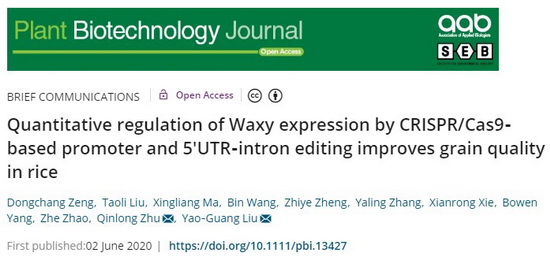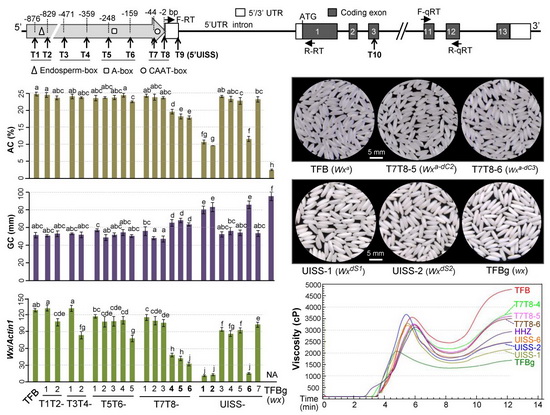CRNTER
Recently, the research team of Academician Liu Yaoguang of School of Life Sciences, State Key Laboratory of Subtropical Agricultural Biological Resources Conservation and Utilization and Guangdong Provincial Laboratory of Modern Agricultural Science and Technology in Lingnan was published online in Plant Biotechnology Journal (IF2018=6.84) A research paper entitled Quantitative regulation of Waxy expression by CRISPR/Cas9-based promoter and 5'UTR-intron editing improves grain quality in rice (DOI: 10.1111/pbi.13427, paper link address: https://onlinelibrary .wiley.com/doi/abs/10.1111/pbi.13427). This study used CRISPR/Cas9-mediated transcriptional level regulation and post-transcriptional level regulation to edit the cis element of the promoter region of the rice Wxa allele and the 5'UTR (non-coding region) intron splice junction to obtain Several practical new Wx alleles have been created, and new indica rice germplasms with different amylose content have been created, which provides new ideas and research methods for rice quality breeding.

The traditional breeding methods are mainly cross-breeding and backcross breeding. This method is not only time-consuming and laborious, but also easy to cause the loss of the excellent traits of the target variety. Genome editing technology can greatly modify the target gene, greatly shorten the breeding time and retain excellent traits. Granule-Bound Starch Synthase I (GBSS I), the conserved Waxy (Wx) gene encoding grains, is a key enzyme in starch synthesis, which controls the endosperm amylose content (AC) and gum consistency (GC) Changes directly affect the taste quality and processing characteristics of cereals. The Wx allelic variation of different rice germplasms produces different ACs. For example, most indica rice has a strong functional allele Wxa, and the endosperm AC is higher (25% or more), the rice is harder and the taste is poor; while the japonica rice has weak functions, etc. Allele Wxb has moderate endosperm AC (15~18%) and softer rice. At present, the editing of Wx is to perform functional knockout on its coding region, and it can only obtain glutinous rice with a loss-of-function mutation (wx) (AC is about 2%).
Tianfeng A/B is an excellent sterile line/maintainer line widely used in three-line hybrid rice, but its Wxa genotype produces higher AC (about 25%), and its hybrid rice has poor taste quality. In this study, the author adopted two strategies for editing the Tianfeng B Wxa promoter region and its 5'UTR intronic splicing site (5'UISS), and expected to knock Low regulation of Wx expression achieves quantitative regulation of rice AC, thereby improving rice quality. The author first analyzed and found that the Wx promoter region contains cis-acting elements such as Endosperm-box, A-box and CAAT-box. Eight targets were designed in these areas, and two adjacent targets were used as a group. Four editing vectors were constructed to transform Tianfeng B, and multiple mutant lines with these functional elements deleted were successfully obtained. Among them, the Wx expression level of the three mutant lines with the deleted CAAT-box was significantly reduced, which reduced the endosperm AC to an appropriate level of 17-18%, and the gel consistency was also improved (Figure 1); the endosperm AC of other mutant lines also had varying degrees decline. Secondly, by editing the Wxa 5'UTR intron splice junction of Tianfeng B, the authors obtained multiple mutant lines that disrupted the 5'UTR intron splice junction (or nearby site), three of which were mutated The AC of the line was reduced to about 9-10%, and a new soft rice germplasm was successfully created (Figure 1). Transcript sequencing analysis showed that the disruption of 5'UISS caused the disorder and stability of Wx post-transcriptional processing splicing, which resulted in a substantial decrease in the level of mature Wx mRNA. The results of this study indicate that gene editing strategies based on transcriptional level regulation and post-transcriptional level regulation can quantitatively regulate the AC of crop seeds. The above research provides a new research strategy for CRISPR/Cas-mediated gene expression regulation, which will help accelerate the research and application of crop genetic breeding improvement.

The first author of the paper is PhD student Zeng Dongchang, and the corresponding authors are academician Liu Yaoguang and young professor Zhu Qinlong. The research was supported by major projects in basic and applied basic research in Guangdong Province, the National Natural Science Foundation of China, and a special project for young top-notch talents in science and technology innovation in the Guangdong Special Support Program.
